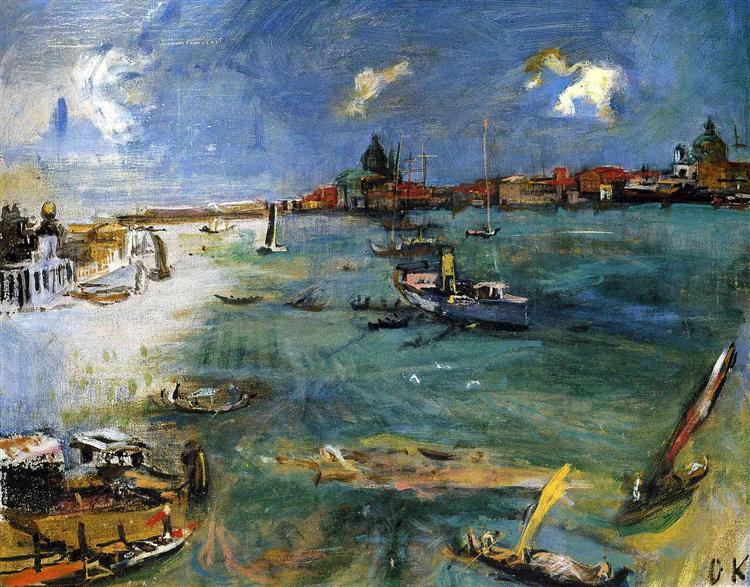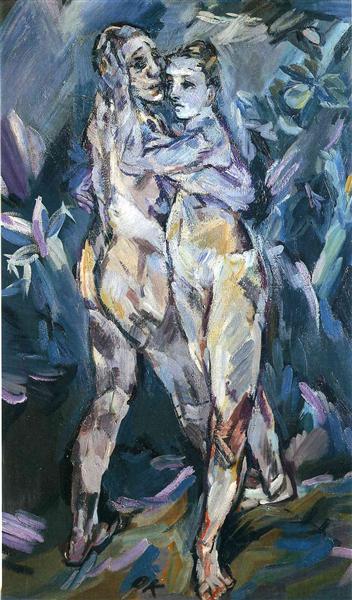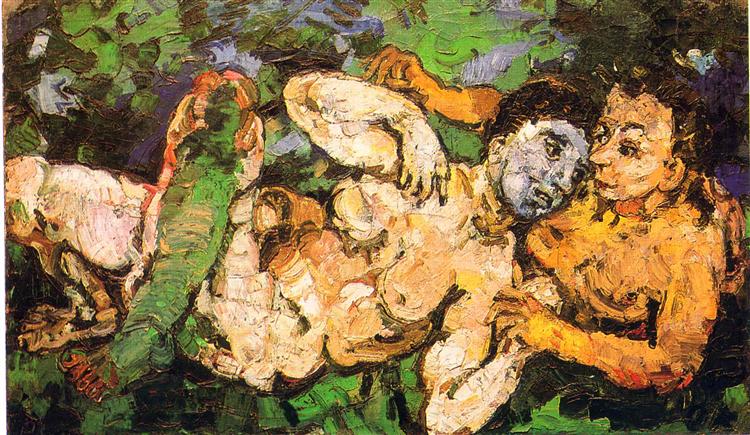Austrian playwright, poet, and painter Oskar Kokoschka is well-known for his expressionistic pieces. Kokoschka, born in Pöchlarn, Austria, on March 1, 1886, is regarded as one of the pioneers of Austrian Expressionism. He first attended the Vienna School of Arts and Crafts before moving on to the Academy of Fine Arts. His early works were influenced by the Vienna Secession movement and painters such as Gustav Klimt. Kokoschka’s work progressed towards Expressionism, distinguished by intense emotion, twisted forms, and vibrant colours.
His painting of his turbulent girlfriend, Alma Mahler, “The Bride of the Wind,” is among his most well-known creations. His political beliefs, feelings, and life experiences were frequently mirrored in his artwork. In addition to painting, Kokoschka was a playwright and poet. His writings on literature often dealt with existentialist, love, and grief themes.
Conflict and controversy dogged Kokoschka’s career, especially in the wake of the German Nazi regime’s ascent to power. During World War II, he fled Austria and travelled to several other nations until relocating to Switzerland. Despite his difficulties, Kokoschka contributed to expressionism and modern art, and his creations are still studied and appreciated today. He passed away in Montreux, Switzerland, on February 22, 1980, leaving a significant artistic legacy.
Expressionist, Migrant, European

Kokoschka would take another year to manifest his position as enfant terrible of pre-war Austrian art: at the Kunstschau in 1909, he presented Murder, Hope of Women. The performance was an expressionist play based on the struggle for power between male and female archetypes (the conqueror and the femme fatale). It caused so much outrage that its creator only narrowly escaped arrest. For all the scandal it caused, the play traced a significant shift in the artistic trajectory of Vienna 1900: moving away from the flowery decadence of art nouveau towards raw expressionism, a new generation of artists challenged the ideals of their predecessors at the dawn of the Great War, Julia Secklehner in the essay, ‘Oskar Kokoschka: Expressionist, Migrant, European’.
According to Julia Secklehner, the exhibition begins with Kokoschka as a young expressionist and peaks in the context of his intense relationship with Alma Mahler. It then moves from Kokoschka’s scandal-making early years to his extensive work as a “soul slasher” portraitist, as Alfred Ehrenstein called his intense psychological portraits. Heartbroken, Kokoschka volunteered to fight in the Great War after they parted ways. However, the trauma of separation appears to be more severe than the trauma of war, as seen by the unsettling dramas and poignant double portraits that unmistakably link the idea of “expressionism” with the image of the troubled artist. It wasn’t until 1919 that Kokoschka’s obsession with Mahler came to an end when he sought solace in beheading a specially- made surrogate doll.
The simultaneous political and personal upheavals of 1918–1919 suggest a hiatus in Kokoschka’s output, exacerbated by his 1919 relocation to Dresden, where he taught at the Academy of Fine Arts until 1924. The exhibition centres on Kokoschka’s travels and movements between Vienna, Dresden, and Prague in the 1920s and 1930s. He moved to these cities following the fall of the First Austrian Republic in 1934. Kokoschka’s “migrant identity,“ akin to that of a person growing up in the late Habsburg Empire, is highlighted here.
Chances to closely examine how formal shifts in Kokoschka’s work might relate to his status as a migrant in interwar Central Europe’s social and political hotbed are lost despite the artist’s frequent travels and relocations. Kokoschka started travelling in the 1910s, spending some time in Berlin. However, the primary themes of the exhibition centre on migration and the emergence of National Socialism, the year that Kokoschka was labelled a “degenerate artist” and included in the notorious Munich exhibition of 1937. One of his paintings was damaged by a Nazi sympathiser in the same year, and the damaged piece served as the centrepiece of a London exhibition featuring émigré artists.

‘Narrated by newspaper clippings and video footage of the ‘Degenerate Art’ exhibition, the presentation of the attack on Kokoschka’s work is also supplemented by a letter in which the artist complains about the incident to the Austrian chancellor Kurt Schuschnigg. That the Austro-fascist regime politicised Kokoschka in their terms in the mid-1930s, showing him as the great ‘Austrian artist’ to spite the NS regime, is, however, barely touched upon, writes Julia Secklehner.
Kokoschka and expressionistic sight
The effect is such that the visions seem actually to modify one’s consciousness, at least in respect of everything that theirown form proposes as their pattern and significance.This change in oneself, which follows on the vision’s penetration of one’svery soul, produces the state of awareness, of expectancy. At the same time there is an outpouring of feeling into the image, which becomes, as it were, the soul’s plastic embodiment… The life of the consciousness is boundless. It interpenetrates the world and is woven through all its imagery- Kokoschka
‘At the close of his address, Kokoschka acknowledged that the catalyst for his work and that which inspired the visions of his inner imagination was the ‘semblance of things’ that he observed and collected from the daily optical stimuli of his contemporary surroundings. More precisely, Kokoschka argued that the awareness of these inner visions, or Gesichte, could not materialize solely through a state of remembering on the viewer’s part but operated on a level of consciousness that allowed the viewer to experience visions within themselves. Kokoschka further posited that this awareness on the viewer’s part was part and parcel to the act of living or optically collecting images from the material world, writes Nathan J. Timpano.
According to Rosa Berland, Kokoschka emphasized expressive plurality of form, movement, and atmosphere in his writing, for instance, when observing the way Titian’s Pietacaptured ontological experience with tricks of light and palette and form to create work of the purest expressive order: “The secret of this strange work cannot be grasped all at once. At first glance, one sees no more than a religious subject dating from when the Pantocrator of Byzantine Christianity gave place to the suffering son of Man who sacrificed himself for man’s sins. —The keynote is set by the motionless, limp figure of the Son of Man in the lap of the blue-clad Mother of God, placed centrally in the depths of a cave.
The dynamic use of colour, abstracted backgrounds, and iconographic dissemblance in Kokoschka’s early paintings all allude to the importance of emotion and are situated in a transient temporal environment that is frequently shrouded in a nocturnal and sfumato haze. In his paintings, the image plane moves and reflects misplaced emotion and importance, similar to the dreaming process. This is frequently depicted in the sitter’s face, covered in the dense aura or the unevenly painted canvas. The sitters appear like figures emerging from the mist of the artist’s imagination, emerging from a fog.

‘This difficulty arises because the paintings’ primary subject is immeasurable and illogical: the painter’s process of artistic vision and insight reveals the workings of his sitter’s inner mind and state of being. Some portraits appear disjointed and unflattering, stark renderings of the subject’s neuroses. His sitters often summarily rejected them, though some later recognized the truth of the depiction. This essay will further investigate Kokoschka’s unique artistic process and the idea that a painting can make a statement in visual terms, writes Rosa Berland.
Throughout the years 1909–1911, Kokoschka painted more than fifty portraits. From the beginning of this highly productive time, the artist deviated more and more from the formal constraints of portraiture and the Secession’s style, adhering less and less to plasticity. Kokoschka was not wholly an exile, despite his story of rejection and the negative criticism in the Viennese press. Architect Adolf Loos introduced Kokoschka to Karl Kraus and other intellectual luminaries after his work at the 1908 Kunstschau, which caused a well-known scandal. He also coordinated for several portrait commissions.
Oskar Kokoschka’s life and work are a tribute to the strength of unique expression and the long-lasting influence of creative innovation. Kokoschka bravely explored the depths of human emotion and experience throughout his turbulent life, capturing the spirit of his day with a vigour and passion that still resonates today. From his early Viennese Secession-influenced paintings to his later expressionistic masterpieces, Kokoschka’s work demonstrates an unwavering pursuit of honesty and truth in art and life.





